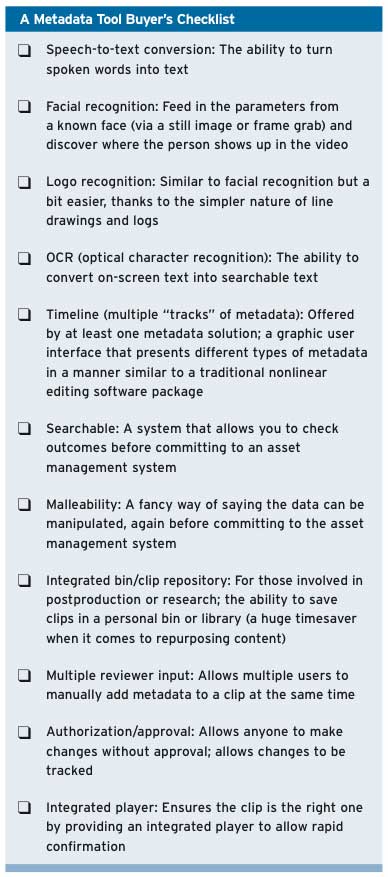Buyer's Guide: Metadata
This article appears in the February/March issue of Streaming Media magazine, the annual Streaming Media Industry Sourcebook. In these Buyer's Guide articles, we don't claim to cover every product or vendor in a particular category, but rather provide our readers with the information they need to make smart purchasing decisions, sometimes using specific vendors or products as exemplars of those features and services.
Consider this scenario: A Cinderella college team finds itself rapidly rising through the ranks during March Madness. Up until now, no major sports or news outlet had paid more than cursory attention to the team’s captain or point guard, but now, every news outlet wants to know -- and see -- more about these two rising stars.
It doesn’t make sense to send copies of every game to every news outlet to let their editors sort through them. But the thought of going through the games to pull out a highlight reel is so daunting, it’s almost impossible. What’s an athletic director’s staff to do?
Fortunately, there are a number of video indexing and metadata extraction options on the market today. They’re available at varying pricing levels and equally varying levels of integration into video editing and streaming solutions.
Before buying one, though, you need to ask a few key questions:
1. Where will the metadata be used? It sounds like such a simple question, but buyers should consider whether metadata is going to be used by the end consumer, by the asset management system, by the postproduction editor, or by a combination of all of these. The level of metadata typically needed by a paying customer is quite different from the metadata a “freemium” customer might expect. But both levels of metadata are just a drop in the bucket compared with what the video clip contains. Setting a level of expectation is key.
 2. Is the content already in file-based form? This sounds like a no-brainer, but there’s a staggering amount of content still being created on tape, in a number of digital and analog formats. Getting the content into a file-based form is labor-intensive, to say the least, but there’s a silver lining: While content is being digitized (or transferred from tape), it’s possible to extract metadata.
2. Is the content already in file-based form? This sounds like a no-brainer, but there’s a staggering amount of content still being created on tape, in a number of digital and analog formats. Getting the content into a file-based form is labor-intensive, to say the least, but there’s a silver lining: While content is being digitized (or transferred from tape), it’s possible to extract metadata.
3. How much metadata is being “lost” during the production process? More than a decade ago, my consulting firm did a study that found about 70% of all production metadata was orphaned as content passed from one part of the production workflow to the next. Today, at least a bit more is being saved, although the number still hovers around 50% in most production and postproduction environments.
A representative from Sony explained it well at a recent Sports Video Group meeting: “The initial thrust of the XDCAM products has been interoperability of the video products,” said Chris Tsai, product manager for optical products at Sony Broadcast, talking about Sony’s optical-based HD cameras and recorders. “Now a lot of our efforts in working with third-party vendors are to enhance and have them make use of the metadata capability that we have.”
4. Does it make more sense to insource or outsource the metadata extraction? The answer depends, of course, on the amount of content you need to extract metadata from, the level of detail required, and the need for it to integrate into your asset management and postproduction workflows.
In our initial scenario, given the rapid time to market and short shelf life of the content, sending it to a metadata extraction service may be the best bet.
In closing, here’s an example of the power of using metadata from service provider Thought Equity Motion (TEM). In conjunction with the Atlantic Coast Conference (ACC), TEM has opened the ACC Vault, which provides an online video archive of men’s basketball games from all 12 ACC member schools.
TEM digitized and metadata tagged more than 100 games, including championship games and classic games the fans still talk about, in order to reconnect fans with their alma maters or favorite sports teams.
Founder and CEO of TEM, Kevin Schaff, noted that 93 seconds is the average length of time a user will spend watching a game that has no metadata. Yet, Schaff explains that once “you add metadata down to the frame level, the average user time goes to 14 minutes. That’s a huge increase in how people come in and consume the game in nonlinear form.”
So in our initial scenario, why not just go through a few games and put together a highlights reel? While that’s certainly one approach, the bigger reason to consider a more thorough metadata scanning of content is the chance to find hidden gems. If you asked sports fans if they’d spend the time watching a game they had already seen, they would typically answer no. Adding metadata changes the equation, though, by allowing sports fans (or reporters) to find those hidden gems.
Related Articles
Designed to sit between consumer apps and backend video systems, this CMS can collect, enrich, and organize metadata for better personalization.
14 Apr 2017
We're growing the Streaming Media brand with Streaming Media Producer and an expanded Buyer's Guide section in this year's Streaming Media Industry Sourcebook.
13 Feb 2012